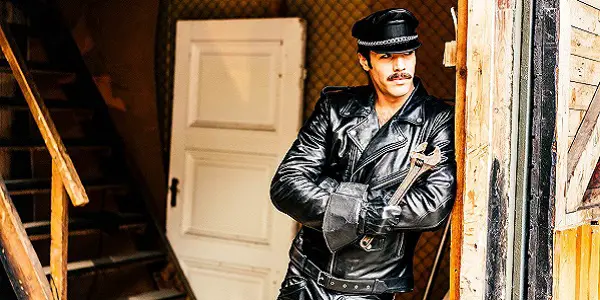TOM OF FINLAND: The Melancholy Of Repression & The Exhilaration Of Freedom

Lee Jutton has directed short films starring a killer toaster,…
Artist Touko Laaksonen, whose highly stylized homoerotic illustrations became famous under his pseudonym Tom of Finland, is the subject of a new movie that has already earned the honor of being Finland’s submission for Best Foreign Language Film at the 2018 Academy Awards. Tom of Finland traces Laaksonen’s journey from the battlefields of World War II to the bustle of post-war Helsinki, where he sat behind a desk at an advertising agency by day and secretly attempted to peddle his artwork by night. In a country where homosexuality was persecuted well into the 20th century, Laaksonen could only find limited, dangerous success. But in America? That’s where his work finally found an appreciative audience, one that was willing to open the doors for him that had been slammed shut in Finland.
Award-winning filmmaker Dome Karukoski, whose next project is a biopic of beloved Lord of the Rings author J.R.R. Tolkien, tries to fit Laaksonen’s resolutely unconventional life into the format of the conventional, awards-baiting biopic, with mixed results. The film feels like two totally different stories – one of post-war persecution in Finland, the other of the freewheeling, free love to be found in 1970s America – that just happen to be united by Pekka Strang’s powerhouse performance as Laaksonen.
From War Hero to Gay Hero
A seemingly unlikely soldier, Laaksonen longs for a peacetime life full of piano-playing and sketching. At night, he engages in secret dalliances in the woods with his superior officer, Captain Alijoki (Taisto Oksanen), while lusting after other broad-shouldered men in uniform – both allies and enemies. Laaksonen survives the war a decorated officer and moves in with his younger sister, Kaija (Jessica Grabowsky), who shares his dreams of becoming a famous artist.

The two of them devote themselves to their day jobs at a Helsinki advertising agency, but Laaksonen cannot deny his obsession with hyper-muscular, uber-masculine men clad in motorcycle leathers, military uniforms, or nothing at all. With homosexuality frowned upon and the possession of pornography a punishable offense, Laaksonen channels his desires into his private art, including the creation of the iconic mustachioed character known as Kake.
Soon Laaksonen reconnects with Alijoki and, through him, becomes introduced to the underground gay scene of Finland, where he finally finds an audience appreciative of his work. Frustrated that his community is forced to remain secret, Laaksonen eventually sends his work to an American magazine, where it becomes a beacon of hope for so many misunderstood young men who have been made to feel that their desires are abnormal.
In the work of Tom of Finland, whether it be printed in pornographic magazines or displayed on the walls of small galleries in the back rooms of leather shops, these men are able to feel normal and unashamed. And in the thriving gay communities of Los Angeles and New York – even as the AIDS crisis begins to sweep the nation – Laaksonen can finally be himself.
A Tale of Two Movies
As previously noted, Tom of Finland feels like two entirely separate films that clash with each other, right down to their different color palettes: the grey, monochromatic and melancholy world of post-war Europe and the bright, sunny and colorful world of gay America. And while the latter might constitute a much happier part of Laaksonen’s life story, and is much pleasanter to look at, it’s definitely the weaker half of the film.

Like many European films that feature American characters and storylines, the English-language dialogue and acting in the American scenes are positively atrocious; all of the characters speak in cliches, and with broad American accents that sound as though the actors have been watching too many old John Wayne movies. It’s wonderful to see Laaksonen come out of his shell and be appreciated by his adoring American fans without having to worry about being arrested. It’s just painful to watch everyone else around him.
The film’s biggest asset is its star, Pekka Strang, who plays Laaksonen as an absolute rock star: a vibrant, creative man who never let society’s expectations get in the way of his happiness. Not traditionally handsome, per se, but still strangely alluring with his sharp eyes and cheekbones – think Graham Chapman at the height of his Monty Python powers – Strang commands the screen even as Laaksonen is attempting to hide from those around him. Not that he wants to hide, or is in any kind of denial about what he finds attractive.
While closeted for his own safety, Laaksonen is refreshingly confident and bold in his sexuality, not hesitating to go cruise in the woods for hookups or travel to Berlin to find potential customers for his art in the sex-fueled clubs of the city. Despite being persecuted for his sexuality, Laaksonen is not tortured about it; the only thing that tortures him is the notion that he has an obligation to fight for equality when he’d rather just go about living his life.

While the latter part of the film is mostly cringeworthy, the first half of the film, in which Laaksonen comes to terms with his role in the war as a killer of men and his attraction to the very men he was supposed to be fighting, is very powerful. One of the film’s best scenes takes place during his time at the advertising agency, when Laaksonen is called in to revamp a bland ad featuring two women sharing coffee. Laaksonen grabs a broad-shouldered male colleague and a buxom blonde and carefully instructs them on how to arrange their bodies in a way that elicits the post-coital glow of two new lovers sharing coffee the morning after.
While this advertisement is far more subtly sexy than the explicit illustrations for which he would become famous, it’s the first moment in the film where one sees Laaksonen’s innate ability to create erotic images on full display. Seeing Laaksonen’s joy once he gets his colleagues’ bodies arranged just so is like watching someone be reborn. It’s a beautiful moment that does indeed feel like a typical biopic trope, but it is executed so well that one doesn’t even care. That is almost entirely due to Strang’s gruffly magnetic performance.
Conclusion: Tom of Finland
Tom of Finland’s work is remembered as controversial, groundbreaking and explicitly, aggressively sexy. To present his life in the format of a prestige biopic feels like a poor fit, to say the least – especially when it feels like two utterly different biopics smashed together. The first half of the film is beautifully made, but in its dourness doesn’t necessarily feel reflective of Laaksonen’s legacy; the second half feels more tonally right, but is executed poorly. Fortunately, Strang’s performance unites both halves to create a watchable whole.
What do you think? How does the work of Tom of Finland deserve to be remembered? Share your thoughts in the comments below.
Tom of Finland was released in New York on October 13, 2017 and in Los Angeles on October 20, 2017. Additional international release dates can be found here.
Does content like this matter to you?
Become a Member and support film journalism. Unlock access to all of Film Inquiry`s great articles. Join a community of like-minded readers who are passionate about cinema - get access to our private members Network, give back to independent filmmakers, and more.
Lee Jutton has directed short films starring a killer toaster, a killer Christmas tree, and a not-killer leopard. Her writing has appeared in publications such as Film School Rejects, Bitch: A Feminist Response to Pop Culture, Bitch Flicks, TV Fanatic, and Just Press Play. When not watching, making, or writing about films, she can usually be found on Twitter obsessing over soccer, BTS, and her cat.













